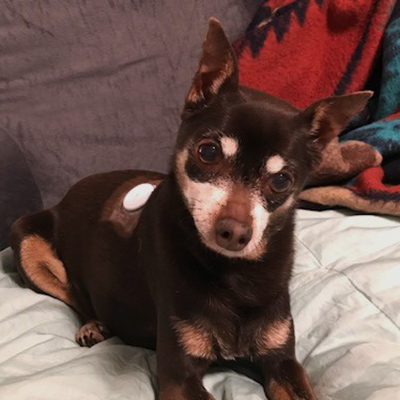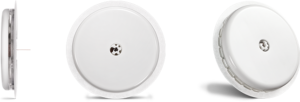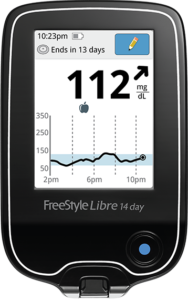Dr. Tiffany Major is an associate veterinarian of Craig Road Animal Hospital, located in northwest Las Vegas. She discusses how owners of diabetic pets can better monitor their blood sugar levels with the FreeStyle Libre Monitoring System.
By Tiffany Major, DVM
If you care for a diabetic dog or cat, you know this disease can be challenging to manage. Most diabetic pets need insulin injections twice daily, but their blood glucose (sugar) levels and insulin needs can change depending on their overall health, how much they are eating, or how stressed they are. Complications from very high or very low blood sugar can be life-threatening and seem to come on quickly.
As Seen on TV – But with Cuter Patients!
If you watch TV, you’ve probably seen commercials for the FreeStyle Libre monitoring system. It’s a needle-free system where a small sensor is attached to the skin and a reader is passed over the sensor to record sugar measurements a few times a day. This is a major breakthrough for patients who have previously had to provide multiple blood samples to get this information. The system was developed for humans, but we can also use it for our pets!
One Measurement Isn’t Enough
In veterinary medicine, the “gold standard” method of measuring whether a pet’s blood sugar is well-controlled has been to perform a serial blood glucose curve, where blood sugar is measured every two hours throughout the day. This test is often performed in the hospital, but some owners are able to do this at home using glucometers calibrated for animals. Curves require new blood samples to be taken each time, either by pricking the ear, the paw pad, inside the lip or by drawing blood from a vein with needle and syringe. For accurate monitoring and proper insulin dosage adjustment, veterinarians need to see how low or high a patient’s glucose gets during the day, and when these high and low points occur.
Stress Matters
As many of us know firsthand, there are more than a few pets out there who do not appreciate having blood samples taken multiple times a day. When curves are done at the hospital, where pets are more likely to be stressed by the unfamiliar environment, smells, and sounds, blood sugar can be affected and read at higher levels. We also know, because we are pet owners ourselves, that it’s hard to see our pets uncomfortable from repeated blood sampling when we can’t explain to them why it’s important.
The FreeStyle Libre system has the ability to change the way we monitor diabetic pets. Without the need for repeated needle-pricks, it reduces pain for the animal, and can also make it much easier for owners to monitor their pets at home. The system consists of two parts:
- The sensor – a disposable piece that attaches to the skin, and has a little filament on the bottom that reads the sugar in the body tissue just underneath the skin. It is about the size of a quarter and is applied to the pet’s neck or side by our team members in the hospital. A small area of hair is shaved before we apply the sensor, which makes a “pop” when applied that can startle some pets, but it shouldn’t be painful during or after application. It doesn’t need to be bandaged or covered. The sensor stores 8 hours of data and can stay on for up to 14 days.
- The reader – this is used to scan the sensor 3 times a day during the monitoring period (which can be anywhere from 1-14 days). Newer models of smartphones can also be converted to sensors by downloading the FreeStyle LibreLink app – which is pretty amazing if you think about it!
Once the sensor is applied by our team, it starts to measure interstitial glucose (the glucose level in the body just under the skin) within one hour. It will continue to measure every minute and record readings every 15 minutes throughout the day for 14 days. The sensor stores data for 8 hours, then will start to record over old measurements. So to record a full 24 hours of readings, the sensor is “scanned” using the reader or smartphone every 8 hours.
The data can easily be uploaded onto a computer and shows up as numbers or graphs. If the readings are being done at home, the data can be sent to our veterinarians to determine whether changes in feeding schedule or insulin dosage are recommended.
It is recommended that the pet wear a light shirt to prevent them from scratching off the sensor. Our veterinarians suggest that this system is not for new diabetics.
How Much Does It Cost?
Diabetes can be an expensive condition to manage, and the FreeStyle system can cut costs significantly by reducing the number of visits a pet has to make for serial glucose curves. Because better monitoring can also cut down on complications from unregulated blood sugar, overall costs for diabetes-related issues may also decrease. Sensors that are used for up to 14 days cost $75.08 each. The reader is a one-time purchase of $70, or you can rent one from us for $35 for 14 days (a refundable deposit will be required.) The LibreLink app, which converts a smartphone to a reader, is free.
When You’re Away
 One of the most problematic aspects of diabetes for pet owners is the difficulty they face in keeping their pets healthy when they need to go out of town. Since stress and schedule changes can affect even a well-regulated diabetic dog or cat, many owners worry that complications will arise if they leave their pet with a sitter, bring them in to board, or even if the pets are traveling with the family to an unfamiliar environment. The FreeStyle system means a pet sitter can monitor glucose levels at home and consult our doctors about changes, and that a pet who is boarding with us can have their levels monitored during their visit to make sure they are staying regulated.
One of the most problematic aspects of diabetes for pet owners is the difficulty they face in keeping their pets healthy when they need to go out of town. Since stress and schedule changes can affect even a well-regulated diabetic dog or cat, many owners worry that complications will arise if they leave their pet with a sitter, bring them in to board, or even if the pets are traveling with the family to an unfamiliar environment. The FreeStyle system means a pet sitter can monitor glucose levels at home and consult our doctors about changes, and that a pet who is boarding with us can have their levels monitored during their visit to make sure they are staying regulated.
Diabetes in pets, and people, can be a tricky disease to manage, but with a little bit of practice, this technology is turning out to be a game-changer for a lot of patients. Please let us know if you’d like to learn more!






